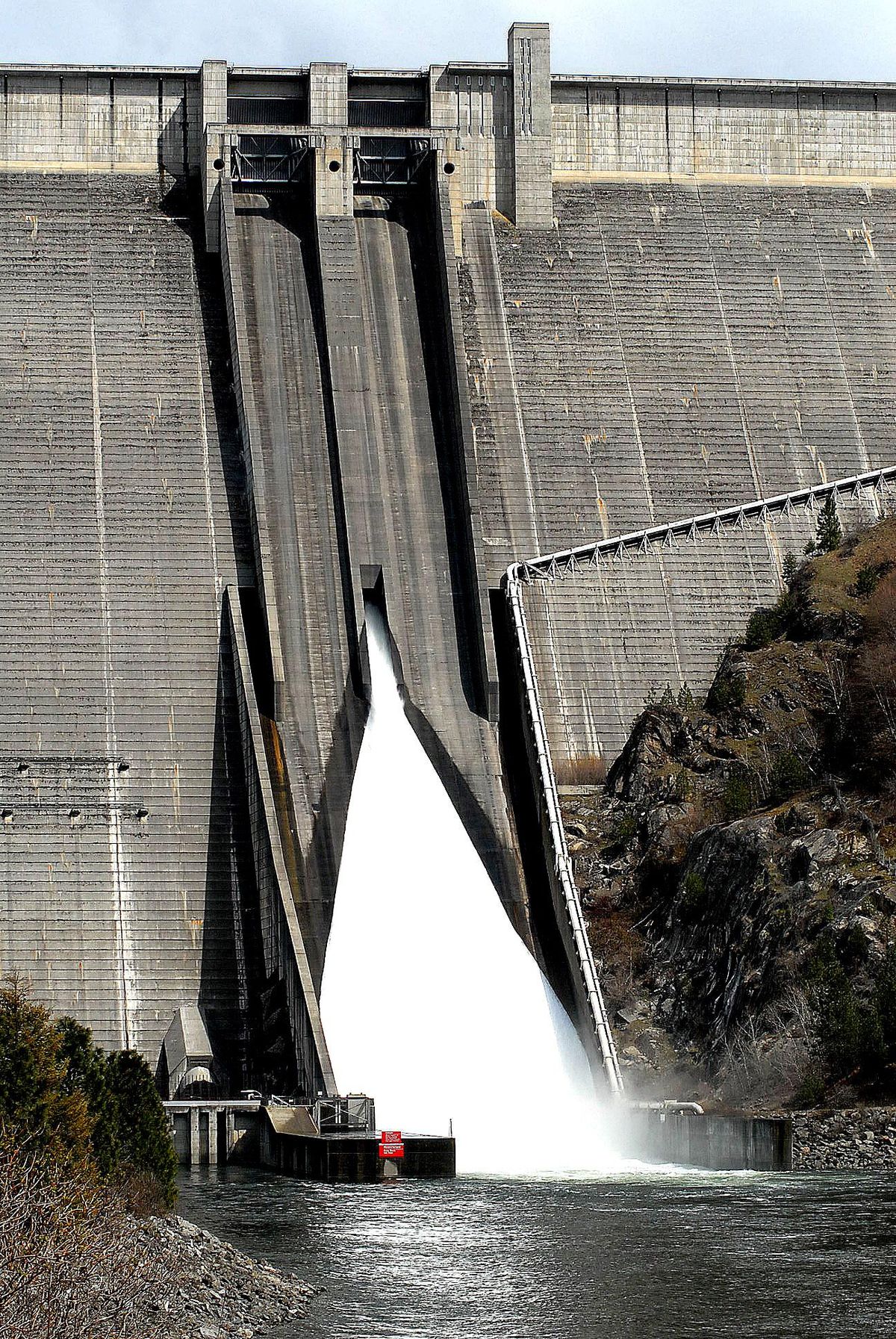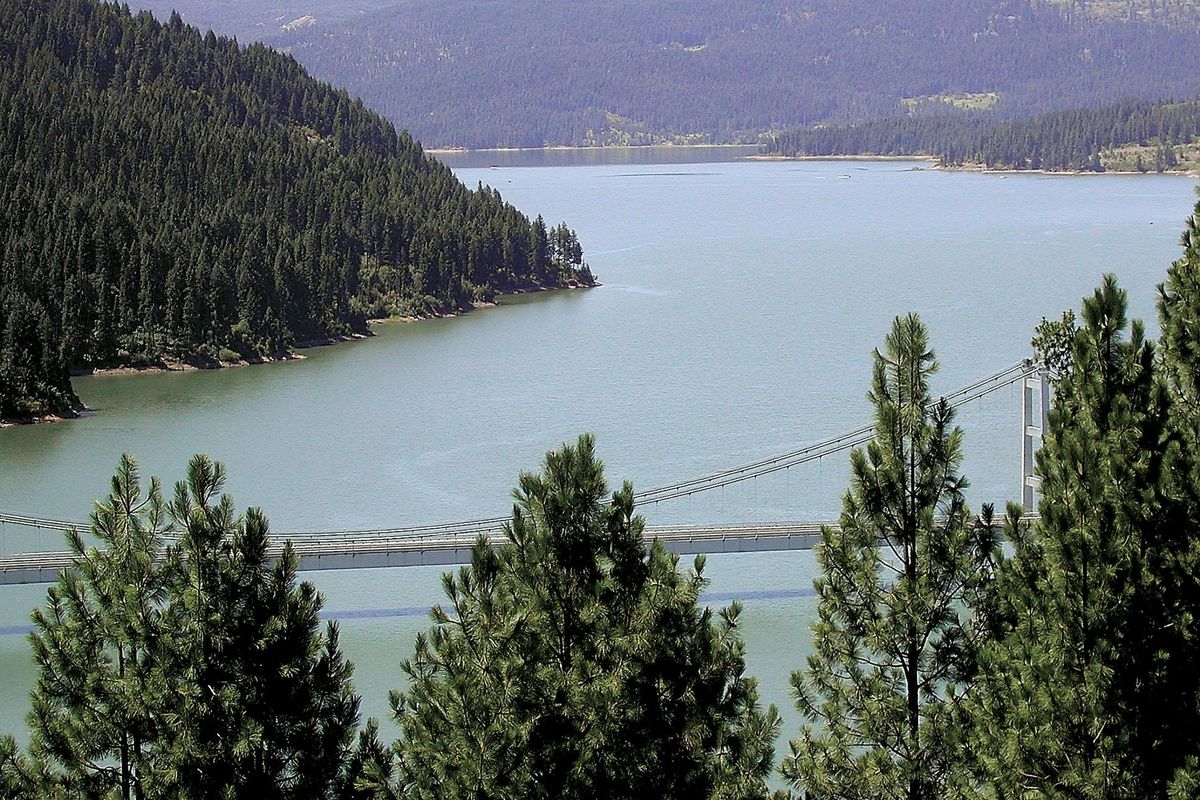WSU scientists say man-made reservoirs may be a contributor to global warming
In this 2008 photo, the spillways of Dworshak Dam churn out excess water in Clearwater County, Idaho. (Barry Kough / Associated Press)
Reservoirs behind dams release significant amounts of greenhouse gases, and their output should be counted in future emissions reporting, says a new study from Washington State University.
More than 1 million reservoirs worldwide produce about 1.3 percent of the greenhouse gas emissions generated by human-caused activity, according to the study. The volume is roughly equivalent to 1 gigaton of carbon dioxide annually, which is more than Canada’s yearly production.
“While reservoirs are often thought of as ‘green’ or carbon-neutral sources of energy, a growing body of work has documented their role as greenhouse gas sources,” researchers wrote in the study that will be published next week in the journal BioScience.
The WSU study noted that reservoirs flood large areas, submerging organic material that produces greenhouse gases as it decomposes. Methane, for instance, is produced when microorganisms breakdown organic matter in parts of the reservoir where oxygen isn’t present.
Reservoirs are generally warmer than free-flowing rivers and they collect nutrients that wash downstream. Reservoirs with high levels of algae and plant growth also had the highest levels of greenhouse gas emissions, the WSU study said.
Reservoirs produce about 25 percent more methane per acre than previously thought, said Bridget Deemer, a research associate at WSU-Vancouver and the study’s lead author. That’s significant, because methane is a powerful greenhouse gas, 34 times more potent than carbon dioxide over the course of a century.
The study has potential implications for the Northwest, which gets about half of its electricity from hydropower dams, and for other dam projects across the globe.
“Dams are being rapidly constructed in Southeast Asia and Latin America,” said John Harrison, an associate professor at WSU-Vancouver. “We need to think more carefully about the greenhouse gas impact of reservoir construction. Reservoirs provide a huge number of benefits, but they’re not neutral with respect to emissions.”
In August, Harrison attended a meeting of the Intergovernmental Panel on Climate Change in Belarus to talk about including reservoirs in countries’ future calculations and reporting of greenhouse gas emissions.
In 2000, BioScience published one of the first research papers to link reservoirs to increased greenhouse gas emissions, but it was based on a handful of studies. The new study expands on that work, looking at published research on 200 reservoirs worldwide.
Deemer and Harrison worked with scientists in China, Canada, Brazil and The Netherlands. The study included information about reservoirs on the Clearwater River in Idaho, the headwaters of the Yakima River in Washington and the Santiam River in Oregon. Not all of the reservoirs in the study were built for hydropower. Some had irrigation or flood control as their primary purpose.
In addition to methane, reservoirs also release carbon dioxide and nitrous oxide. But methane was the most important contributor, accounting for about 80 percent of the heat-trapping potential of the emissions released, Deemer said.
“By no means would I put a hydroelectric reservoir in the same category as a coal plant, which is a more direct emitter of carbon dioxide to the environment,” said David Butman, an assistant professor of environmental sciences at the University of Washington, who wasn’t involved in the study.
However, scientists are trying to understand how man-made reservoirs affect the release of greenhouse gases, which occurs naturally with the breakdown of organic material in lakes, rivers and ponds, Butman said. The WSU study is a helpful step in an area of emerging science, he said.
Last summer, Butman boated parts of the Columbia and Snake rivers, taking measurements of carbon dioxide and methane at the reservoirs. The research, which is in the beginning stages, is looking for answers about how those reservoirs affect greenhouse gas emissions. The work is being done in collaboration with the U.S. Geological Survey and WSU.
Butman wants to know if the emissions from Columbia and Snake reservoirs are “big enough to matter,” and if they can be managed “so that we can continue to think of reservoirs under the umbrella of green power.”
On a hopeful note, Deemer and Harrison found that improving water quality reduced reservoirs’ output of greenhouse gas emissions.
Keeping phosphorus and nitrogen out of the reservoirs by controlling runoff from fertilizers, manure and other sources reduced both algae growth and emissions.
“Nitrogen and phosphorus lead to a suite of problems in waterways,” Harrison said. “Maintaining healthy ecosystems in rivers and reservoirs might also reduce greenhouse gas emissions.
“That’s our working hypothesis,” he said. “We’re excited to pursue that in future research.”

